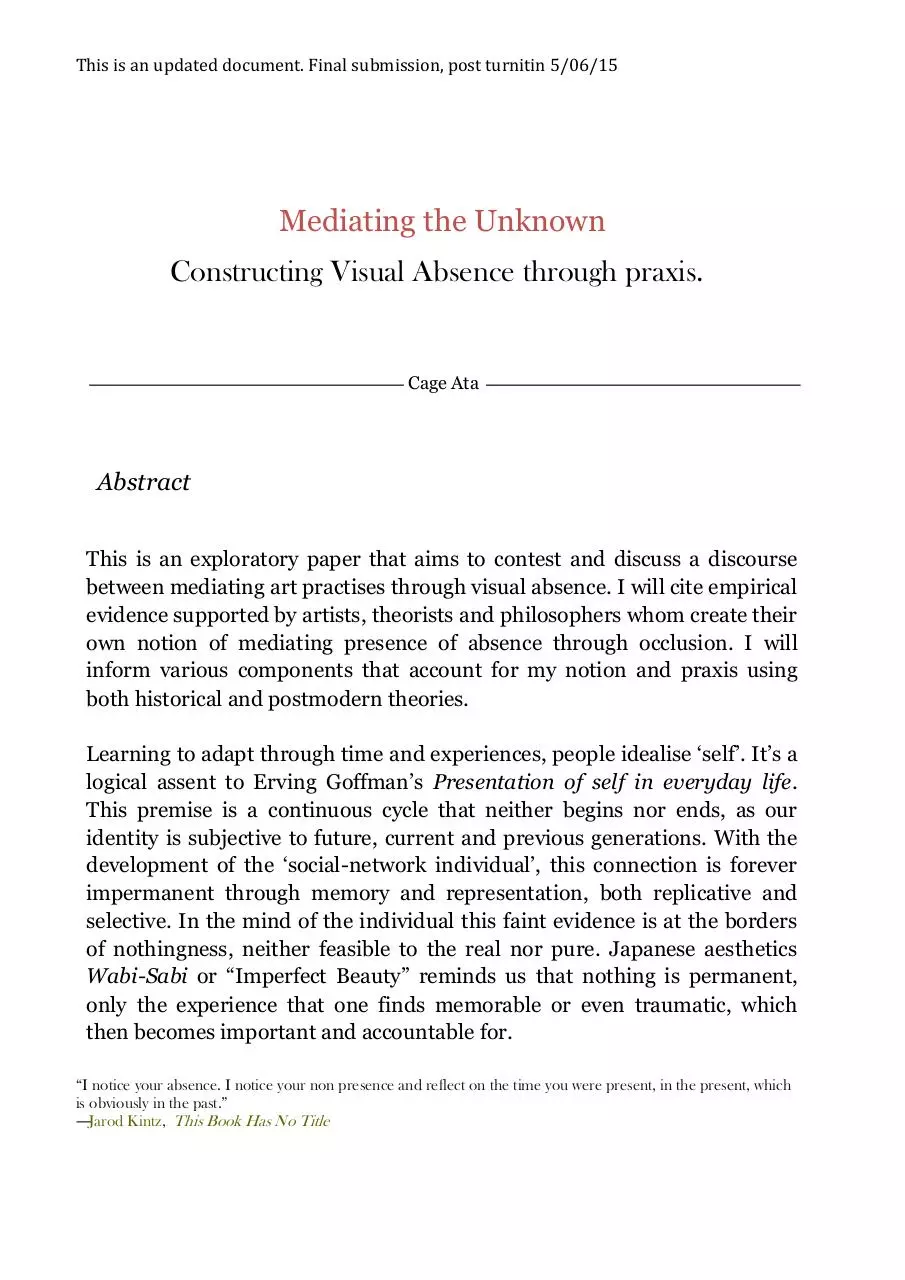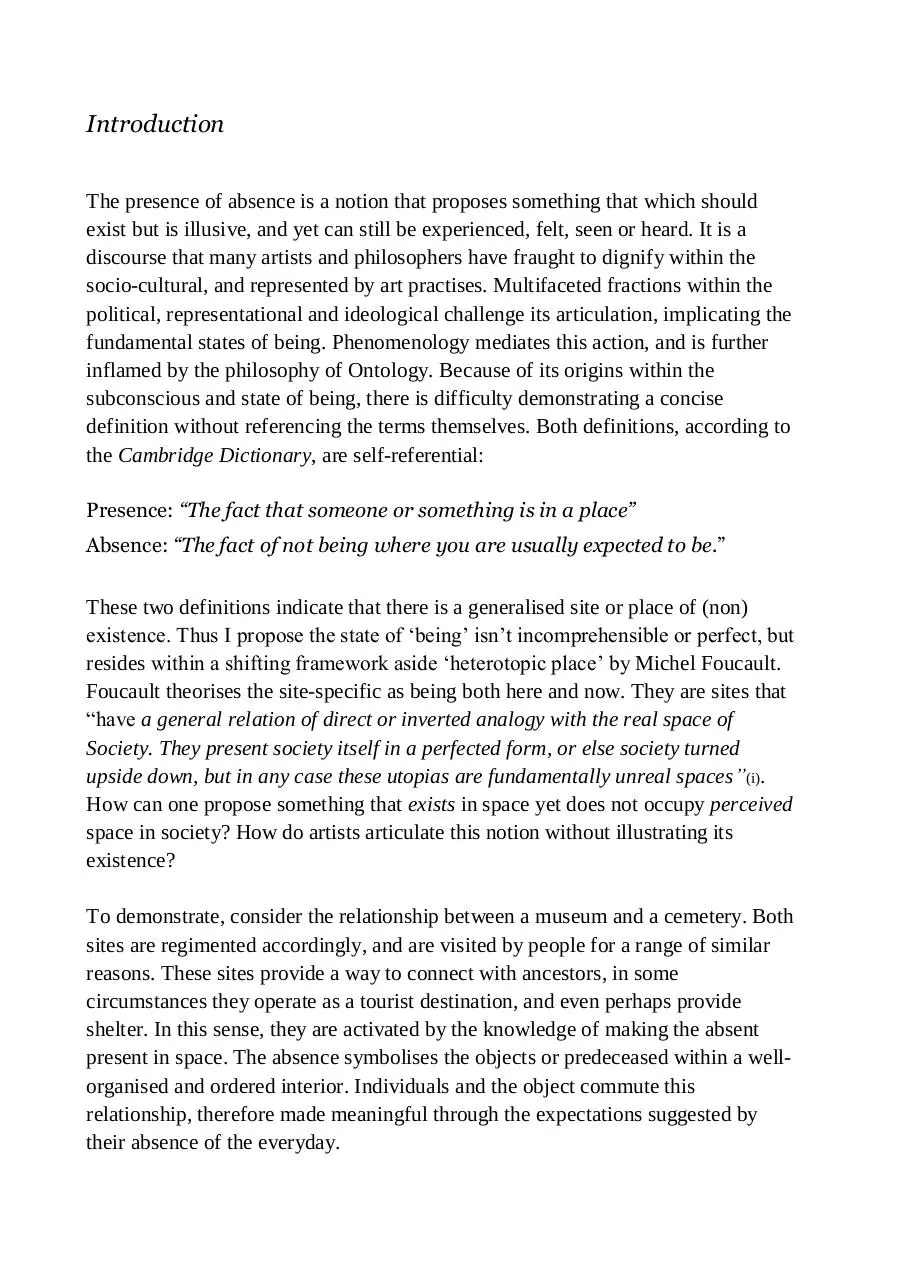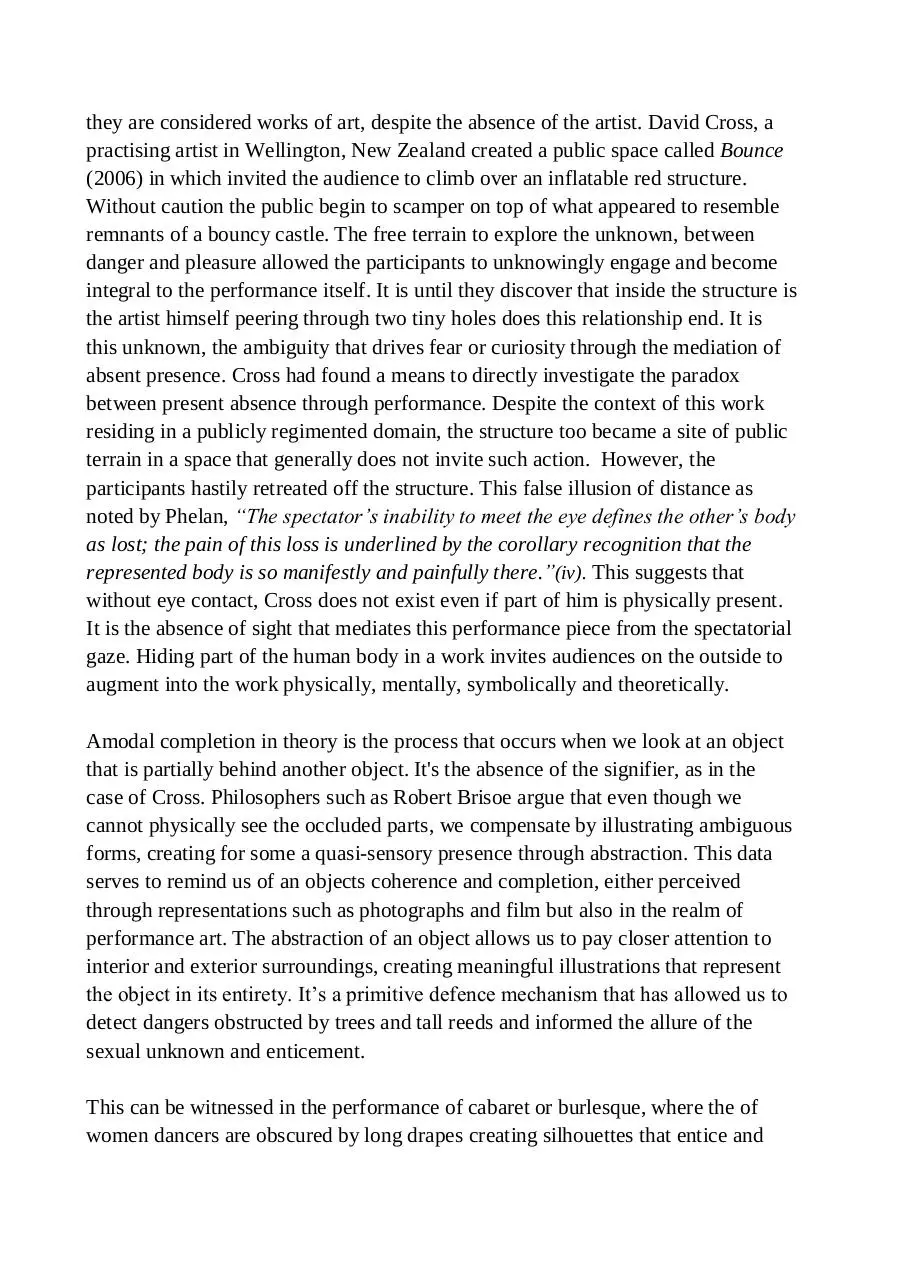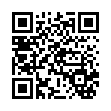Mediating Existence.docx (PDF)
File information
Author: source source
This PDF 1.6 document has been generated by Microsoft Word / , and has been sent on pdf-archive.com on 29/08/2016 at 05:00, from IP address 118.92.x.x.
The current document download page has been viewed 328 times.
File size: 483.68 KB (6 pages).
Privacy: public file





File preview
This is an updated document. Final submission, post turnitin 5/06/15
Mediating the Unknown
Constructing Visual Absence through praxis.
Cage Ata
Abstract
This is an exploratory paper that aims to contest and discuss a discourse
between mediating art practises through visual absence. I will cite empirical
evidence supported by artists, theorists and philosophers whom create their
own notion of mediating presence of absence through occlusion. I will
inform various components that account for my notion and praxis using
both historical and postmodern theories.
Learning to adapt through time and experiences, people idealise ‘self’. It’s a
logical assent to Erving Goffman’s Presentation of self in everyday life.
This premise is a continuous cycle that neither begins nor ends, as our
identity is subjective to future, current and previous generations. With the
development of the ‘social-network individual’, this connection is forever
impermanent through memory and representation, both replicative and
selective. In the mind of the individual this faint evidence is at the borders
of nothingness, neither feasible to the real nor pure. Japanese aesthetics
Wabi-Sabi or “Imperfect Beauty” reminds us that nothing is permanent,
only the experience that one finds memorable or even traumatic, which
then becomes important and accountable for.
“I notice your absence. I notice your non presence and reflect on the time you were present, in the present, which
is obviously in the past.”
―Jarod Kintz, This Book Has No Title
Introduction
The presence of absence is a notion that proposes something that which should
exist but is illusive, and yet can still be experienced, felt, seen or heard. It is a
discourse that many artists and philosophers have fraught to dignify within the
socio-cultural, and represented by art practises. Multifaceted fractions within the
political, representational and ideological challenge its articulation, implicating the
fundamental states of being. Phenomenology mediates this action, and is further
inflamed by the philosophy of Ontology. Because of its origins within the
subconscious and state of being, there is difficulty demonstrating a concise
definition without referencing the terms themselves. Both definitions, according to
the Cambridge Dictionary, are self-referential:
Presence: “The fact that someone or something is in a place”
Absence: “The fact of not being where you are usually expected to be.”
These two definitions indicate that there is a generalised site or place of (non)
existence. Thus I propose the state of ‘being’ isn’t incomprehensible or perfect, but
resides within a shifting framework aside ‘heterotopic place’ by Michel Foucault.
Foucault theorises the site-specific as being both here and now. They are sites that
“have a general relation of direct or inverted analogy with the real space of
Society. They present society itself in a perfected form, or else society turned
upside down, but in any case these utopias are fundamentally unreal spaces”(i).
How can one propose something that exists in space yet does not occupy perceived
space in society? How do artists articulate this notion without illustrating its
existence?
To demonstrate, consider the relationship between a museum and a cemetery. Both
sites are regimented accordingly, and are visited by people for a range of similar
reasons. These sites provide a way to connect with ancestors, in some
circumstances they operate as a tourist destination, and even perhaps provide
shelter. In this sense, they are activated by the knowledge of making the absent
present in space. The absence symbolises the objects or predeceased within a wellorganised and ordered interior. Individuals and the object commute this
relationship, therefore made meaningful through the expectations suggested by
their absence of the everyday.
Mediums such as photography, paint or performance, indicate the states of which
presence and absence rely as seen in Paul Seawright’s series, Invincible Cities.
Throughout history scholars such as Phaedrus Plato have contested whether or not
both presence and truth are relative to one another. From Plato’s Phaedrus, Plato
in Twelve Volumes, Vol 9 (ii) he challenged the truth of speech that is not
transformed through an interference over writing. Speech is dictated from the
presence of the speaker while text refers as the signifier to this presence. Therefore,
I contest that representation in the form of writing or photographs is a vehicle that
denotes presence through mediation and any form of representation can be said to
encompass absent presence. According to Jacques Derrida, however, these
mediated forms are binary such as:
Woman/Man
Presence/Absence
Speech/Writing.
They are the only available forms of presence proposed by Derrida, because
meaning cannot appear outside of a medium. Plato, however, is concerned about
the integral mimesis of representations. The illusion of presentation draws the
mind closer to ‘true being’ where it refers to the ultimate state of unmediated
presence. One must consider the implications that speech and writing are
themselves representations, denoting an absence from the extraction of time and
experience. It falls into supplying a link between space and time, and it is this
distance that causes problems from mistrust and communicated virtues.
This association between the documented and speech is investigated within
postmodern and historical performance art. The hypothesis contests the various
issues that surround the binary of ‘now’ and the documented (absence of live)
performance. It is proposed that an act that is not performed live immediately
becomes a representation becoming something other than a performance. As
prescribed by Peggy Phelan in Unmarked: The Politics of Performance,
“Performance’s only life is in the present. Performance cannot be saved, recorded,
documented, or otherwise participate in the circulation of representations of
representations…” (iii). This proposes that the consumption of the individual’s
presence is vital to the integrity of the artist. Any form of absence would denote
the performance futile. I contest that performance art is not only functional through
live, but becomes present through the absence of the now, providing a means to
negotiate knowledge to a larger audience through absence (the document). In my
second annotation, I engaged with artist Erin Whittier in her work, All things
change – Nothing perishes. Whittier’s piece provides further negotiation around
this discourse through the remarks of time and trace within the linguistics of
writing and the body, an event that was never provided public access. Derrida’s
philosophy of writing intrinsically transcends to the very aspect of Whittiers work.
Her imprints on the paper, abstracted as they are, formulate a language or speech
binary to representation and therefore can be considered as a form of presence in
the absence of an audience.
Phillip Auslander, a professor in the School of Literature, Media and
Communication of the Georgia Institute of Technology challenges presence by
arguing that documentation does more than just describe or represent an event but
has the capacity to supplement the event itself in his paper, The Performativity of
Performance Documentation. He positions two artists, Chris Burden’s Shoot
(1971) and Yves Klein’s Leap in the Void (1960). Auslander places these two
performances into what he cites as ‘documentary’. This document offers a record
that the event had taken place but also to prove the existence of the performance
absent from any live audience. Through absence in what Vito Acconci’s names
“performed photography” an example is Cindy Sherman’s Untitled self-portrait
series, the document becomes crucial to the performance as it gains authority by
being recorded. Through the absence in photo-documentation the artist assumes
responsibility to an audience other than the proposed one. This informs a
relationship between the spectator and the artist empowering the audience to think
individually and therefore leaving space for imagination, at the mercy of
representation and memory.
This discourse proposed by Auslander opens invitation to mediation. The
perception of such questions what happens to the performance where rather the
body present in space over time is obscured, absent or simply not in the final
manifestation of the event itself. How do we then negotiate the absence of presence
when the presence is proposed to be exclusive in performance art? This can be
explored through artists whom hire people to perform their act, for example, artist
Marina Abramovic who often uses disciples to enact her own mentality,
encouraging the audience to activate or create the presentation in space themselves.
These individuals are often hired by artists with some notion of agreement that
they are considered works of art, despite the absence of the artist. David Cross, a
practising artist in Wellington, New Zealand created a public space called Bounce
(2006) in which invited the audience to climb over an inflatable red structure.
Without caution the public begin to scamper on top of what appeared to resemble
remnants of a bouncy castle. The free terrain to explore the unknown, between
danger and pleasure allowed the participants to unknowingly engage and become
integral to the performance itself. It is until they discover that inside the structure is
the artist himself peering through two tiny holes does this relationship end. It is
this unknown, the ambiguity that drives fear or curiosity through the mediation of
absent presence. Cross had found a means to directly investigate the paradox
between present absence through performance. Despite the context of this work
residing in a publicly regimented domain, the structure too became a site of public
terrain in a space that generally does not invite such action. However, the
participants hastily retreated off the structure. This false illusion of distance as
noted by Phelan, “The spectator’s inability to meet the eye defines the other’s body
as lost; the pain of this loss is underlined by the corollary recognition that the
represented body is so manifestly and painfully there.”(iv). This suggests that
without eye contact, Cross does not exist even if part of him is physically present.
It is the absence of sight that mediates this performance piece from the spectatorial
gaze. Hiding part of the human body in a work invites audiences on the outside to
augment into the work physically, mentally, symbolically and theoretically.
Amodal completion in theory is the process that occurs when we look at an object
that is partially behind another object. It's the absence of the signifier, as in the
case of Cross. Philosophers such as Robert Brisoe argue that even though we
cannot physically see the occluded parts, we compensate by illustrating ambiguous
forms, creating for some a quasi-sensory presence through abstraction. This data
serves to remind us of an objects coherence and completion, either perceived
through representations such as photographs and film but also in the realm of
performance art. The abstraction of an object allows us to pay closer attention to
interior and exterior surroundings, creating meaningful illustrations that represent
the object in its entirety. It’s a primitive defence mechanism that has allowed us to
detect dangers obstructed by trees and tall reeds and informed the allure of the
sexual unknown and enticement.
This can be witnessed in the performance of cabaret or burlesque, where the of
women dancers are obscured by long drapes creating silhouettes that entice and
fixate the male gaze for an approaching seduction. Despite the conspicuous
pictorial of the womans bodies in space, Brisoe’s theory still applies yet is
mediated differently from Cross’s work. The body’s entirely is obstructed by the
drapes, illustrated by the lights overhead. This example operates the same because
although the audience are aware the women are present, their physical existence is
absent from view, leading to a climax of excitement and enticement.
Download Mediating Existence.docx
Mediating Existence.docx.pdf (PDF, 483.68 KB)
Download PDF
Share this file on social networks
Link to this page
Permanent link
Use the permanent link to the download page to share your document on Facebook, Twitter, LinkedIn, or directly with a contact by e-Mail, Messenger, Whatsapp, Line..
Short link
Use the short link to share your document on Twitter or by text message (SMS)
HTML Code
Copy the following HTML code to share your document on a Website or Blog
QR Code to this page

This file has been shared publicly by a user of PDF Archive.
Document ID: 0000474350.